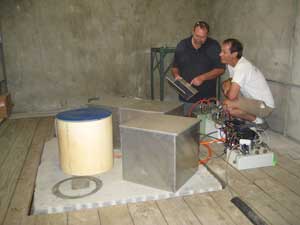GSN Installs First Station With Next-Generation System Design
The first fully-integrated Next-Generation Global Seismographic Network System (NGS) was installed on April 29 by Project IDA at the Piñon Flats Observatory (PFO) in Southern California. This station uses a new design developed jointly by the Albuquerque Seismological Laboratory and Project IDA that incorporates a sensor interface box and power distribution module with the Quanterra Q330HR data acquisition system. The NGS standardizes the stations of the Global Seismographic Network between the network operators, allowing more uniform installation, operation and maintenance techniques for the network. In the near future, the Albuquerque Seismological Laboratory will install its first NGS at station ANMO in Albuquerque, New Mexico. Both organizations will use the NGS design to upgrade other stations in the Global Seismographic Network over the next several years.
|
|
IDA personnel David Chavez, with laptop, and Todd Johnson in the vault at station PFO. The seismometers are underneath the cylindrical container (STS-2) and the three cubes (STS-1 components) in the center of the photo. The electronics supporting the seismometers are along the right-hand side and are, from front to back, (a) the power distribution box (white box), (b) two Q330HR data acquisition systems (black boxes with orange cords), (c) the new sensor interface box, and (d) three feedback electronics boxes for the STS-1 sensors. |
The Albuquerque Seismological Laboratory is part of the US Geological Survey whose charge includes the maintenance of approximately 90 stations of the Global Seismographic Network. Station upgrades to the NGS design are made possible by a partnership between IRIS and the US Geological Survey. Project IDA (International Deployment of Accelerometers) is operated by the Institute of Geophysics and Planetary Physics at the Scripps Institution of Oceanography, University of California, San Diego and is funded by IRIS to operate about 40 stations in the Global Seismographic Network.



